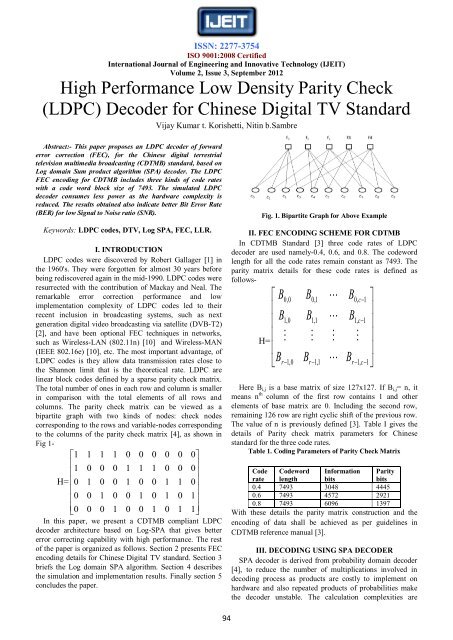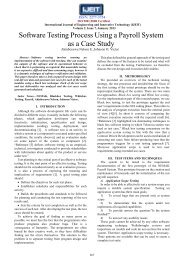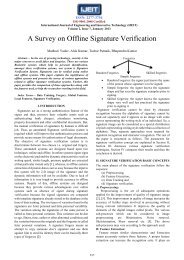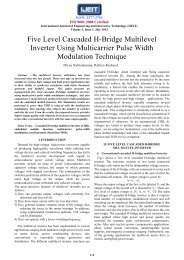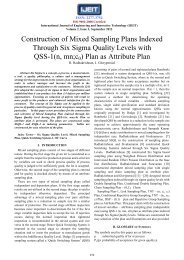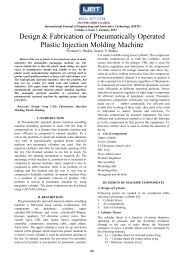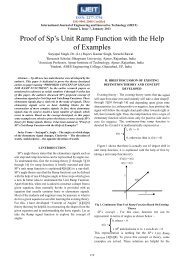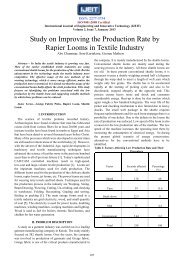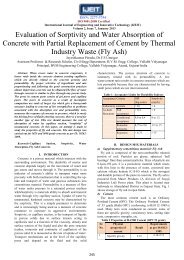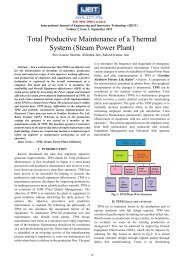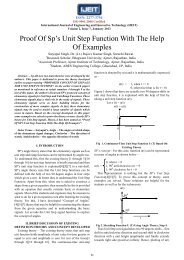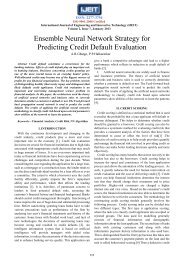high performance low density parity check (ldpc) decoder for ... - ijeit
high performance low density parity check (ldpc) decoder for ... - ijeit
high performance low density parity check (ldpc) decoder for ... - ijeit
You also want an ePaper? Increase the reach of your titles
YUMPU automatically turns print PDFs into web optimized ePapers that Google loves.
ISSN: 2277-3754<br />
ISO 9001:2008 Certified<br />
International Journal of Engineering and Innovative Technology (IJEIT)<br />
Volume 2, Issue 3, September 2012<br />
High Per<strong>for</strong>mance Low Density Parity Check<br />
(LDPC) Decoder <strong>for</strong> Chinese Digital TV Standard<br />
Vijay Kumar t. Korishetti, Nitin b.Sambre<br />
Abstract:- This paper proposes an LDPC <strong>decoder</strong> of <strong>for</strong>ward<br />
error correction (FEC), <strong>for</strong> the Chinese digital terrestrial<br />
television multimedia broadcasting (CDTMB) standard, based on<br />
Log domain Sum product algorithm (SPA) <strong>decoder</strong>. The LDPC<br />
FEC encoding <strong>for</strong> CDTMB includes three kinds of code rates<br />
with a code word block size of 7493. The simulated LDPC<br />
<strong>decoder</strong> consumes less power as the hardware complexity is<br />
reduced. The results obtained also indicate better Bit Error Rate<br />
(BER) <strong>for</strong> <strong>low</strong> Signal to Noise ratio (SNR).<br />
Keywords: LDPC codes, DTV, Log SPA, FEC, LLR.<br />
I. INTRODUCTION<br />
LDPC codes were discovered by Robert Gallager [1] in<br />
the 1960's. They were <strong>for</strong>gotten <strong>for</strong> almost 30 years be<strong>for</strong>e<br />
being rediscovered again in the mid-1990. LDPC codes were<br />
resurrected with the contribution of Mackay and Neal. The<br />
remarkable error correction <strong>per<strong>for</strong>mance</strong> and <strong>low</strong><br />
implementation complexity of LDPC codes led to their<br />
recent inclusion in broadcasting systems, such as next<br />
generation digital video broadcasting via satellite (DVB-T2)<br />
[2], and have been optional FEC techniques in networks,<br />
such as Wireless-LAN (802.11n) [10] and Wireless-MAN<br />
(IEEE 802.16e) [10], etc. The most important advantage, of<br />
LDPC codes is they al<strong>low</strong> data transmission rates close to<br />
the Shannon limit that is the theoretical rate. LDPC are<br />
linear block codes defined by a sparse <strong>parity</strong> <strong>check</strong> matrix.<br />
The total number of ones in each row and column is smaller<br />
in comparison with the total elements of all rows and<br />
columns. The <strong>parity</strong> <strong>check</strong> matrix can be viewed as a<br />
bipartite graph with two kinds of nodes: <strong>check</strong> nodes<br />
corresponding to the rows and variable-nodes corresponding<br />
to the columns of the <strong>parity</strong> <strong>check</strong> matrix [4], as shown in<br />
Fig 1-<br />
1<br />
1 1 1 0 0 0 0 0 0<br />
<br />
<br />
<br />
1 0 0 0 1 1 1 0 0 0<br />
<br />
H= 0<br />
1 0 0 1 0 0 1 1 0<br />
<br />
<br />
0<br />
0 1 0 0 1 0 1 0 1<br />
<br />
0<br />
0 0 1 0 0 1 0 1 1<br />
<br />
In this paper, we present a CDTMB compliant LDPC<br />
<strong>decoder</strong> architecture based on Log-SPA that gives better<br />
error correcting capability with <strong>high</strong> <strong>per<strong>for</strong>mance</strong>. The rest<br />
of the paper is organized as fol<strong>low</strong>s. Section 2 presents FEC<br />
encoding details <strong>for</strong> Chinese Digital TV standard. Section 3<br />
briefs the Log domain SPA algorithm. Section 4 describes<br />
the simulation and implementation results. Finally section 5<br />
concludes the paper.<br />
Fig. 1. Bipartite Graph <strong>for</strong> Above Example<br />
II. FEC ENCODING SCHEME FOR CDTMB<br />
In CDTMB Standard [3] three code rates of LDPC<br />
<strong>decoder</strong> are used namely-0.4, 0.6, and 0.8. The codeword<br />
length <strong>for</strong> all the code rates remain constant as 7493. The<br />
<strong>parity</strong> matrix details <strong>for</strong> these code rates is defined as<br />
fol<strong>low</strong>s-<br />
H=<br />
B<br />
<br />
<br />
B<br />
<br />
<br />
Br<br />
0,0<br />
1,0<br />
1,0<br />
B<br />
B<br />
B<br />
0,1<br />
1,1<br />
<br />
r1,1<br />
<br />
<br />
<br />
<br />
B<br />
B<br />
B<br />
0, c1<br />
1, c1<br />
<br />
r1,<br />
c1<br />
<br />
<br />
<br />
<br />
<br />
<br />
Here B i,j is a base matrix of size 127x127. If B i,j = n, it<br />
means n th column of the first row contains 1 and other<br />
elements of base matrix are 0. Including the second row,<br />
remaining 126 row are right cyclic shift of the previous row.<br />
The value of n is previously defined [3]. Table I gives the<br />
details of Parity <strong>check</strong> matrix parameters <strong>for</strong> Chinese<br />
standard <strong>for</strong> the three code rates.<br />
Table 1. Coding Parameters of Parity Check Matrix<br />
Code<br />
rate<br />
Codeword<br />
length<br />
In<strong>for</strong>mation<br />
bits<br />
Parity<br />
bits<br />
0.4 7493 3048 4445<br />
0.6 7493 4572 2921<br />
0.8 7493 6096 1397<br />
With these details the <strong>parity</strong> matrix construction and the<br />
encoding of data shall be achieved as per guidelines in<br />
CDTMB reference manual [3].<br />
III. DECODING USING SPA DECODER<br />
SPA <strong>decoder</strong> is derived from probability domain <strong>decoder</strong><br />
[4], to reduce the number of multiplications involved in<br />
decoding process as products are costly to implement on<br />
hardware and also repeated products of probabilities make<br />
the <strong>decoder</strong> unstable. The calculation complexities are<br />
94
ISSN: 2277-3754<br />
ISO 9001:2008 Certified<br />
International Journal of Engineering and Innovative Technology (IJEIT)<br />
Volume 2, Issue 3, September 2012<br />
reduced using<br />
] property of<br />
SPA method [4]. The summary of equations <strong>for</strong> Log SPA is<br />
as fol<strong>low</strong>s-<br />
Step 1 Initialization:<br />
The LLR value of the received symbol Yi is initialized to the<br />
corresponding variable nodes L(c i ) using Equation 1 and<br />
associate these L(c i ) values with nonzero elements of <strong>parity</strong><br />
<strong>check</strong> matrix H using Equation 2.<br />
L(c i ) = LLR (Y i ) (1)<br />
L(q ij ) = H. * L(c i ) (2)<br />
L(r ji ) = 0 (3)<br />
Where,<br />
Decoding process stops one the <strong>parity</strong> <strong>check</strong> H*C T =0 is met<br />
otherwise go to step 2.<br />
IV. SIMULATION RESULTS<br />
Fig 2, Fig 3, Fig 4 shows the bit error rates (BER)<br />
<strong>per<strong>for</strong>mance</strong> versus signal-to-noise ratio Eb/N0, over an<br />
AWGN channel <strong>for</strong> proposed CDTMB standard Log SPA<br />
LDPC <strong>decoder</strong>. This simulation are <strong>for</strong> the block size of<br />
7493 and is run <strong>for</strong> the code rates 0.4, 0.6 and 0.8 with QAM<br />
4 modulation scheme, <strong>for</strong> 20 iterations. The results plotted<br />
meet the CDTMB requirement and proves the <strong>high</strong> error<br />
correcting capability of SPA codes in comparison with<br />
Single scan Min sum algorithm.<br />
L(c i ) = LLR value of input bit Y i =<br />
Pr( ci<br />
Log<br />
Pr(<br />
ci<br />
0 | Y <br />
<br />
1| Y)<br />
<br />
L(q ij ) =<br />
L(r ji ) =<br />
q<br />
Log <br />
<br />
q<br />
r<br />
Log <br />
<br />
r<br />
ij<br />
ji<br />
ij<br />
ji<br />
(0) <br />
<br />
(1) <br />
(0) <br />
<br />
(1) <br />
Fig 2. BER Per<strong>for</strong>mance Curve <strong>for</strong> 0.4 Code Rate with QAM-4<br />
Step 2 Horizontal scan (Check node update)<br />
Where,<br />
L(r ji ) =<br />
<br />
i' . ( ( ))<br />
V j \ i'<br />
j<br />
i'<br />
j<br />
i i'<br />
V<br />
j \ i<br />
(4)<br />
( x)<br />
logtanh(<br />
x / 2) <br />
ij<br />
<br />
Sign L<br />
( q ij<br />
) <br />
Fig 3. BER Per<strong>for</strong>mance Curve <strong>for</strong> 0.6 Code Rate with QAM-4<br />
<br />
ij<br />
<br />
L<br />
( q ij)<br />
Step 3 Vertical Scan (Variable node update)<br />
L(q ij ) = L(c i ) + L(<br />
rji<br />
)<br />
(5)<br />
j'<br />
c<br />
\ j<br />
i<br />
Step 4 Decision Loop<br />
L(Q i ) = L(c i ) + L r )<br />
(6)<br />
j ci<br />
( ji<br />
c i = 1 if L(Q i )>0, 0 elsewhere<br />
Fig 4. BER Per<strong>for</strong>mance Curve <strong>for</strong> 0.8 Code Rate with QAM-4<br />
V. CONCLUSION<br />
In this paper we present the implementation and<br />
evaluation of LDPC <strong>decoder</strong> <strong>for</strong> the CDTMB standard using<br />
Log-Domain SPA. It is seen by the simulation that this<br />
95
ISSN: 2277-3754<br />
ISO 9001:2008 Certified<br />
International Journal of Engineering and Innovative Technology (IJEIT)<br />
Volume 2, Issue 3, September 2012<br />
algorithm has better error correcting capabilities. The results<br />
also show that the BER <strong>per<strong>for</strong>mance</strong> of LDPC <strong>decoder</strong> is<br />
close to Shannon limit.<br />
VI. ACKNOWLEDGEMENT<br />
We would like to thank Mr. Abhijeet Magdum from<br />
Saankhya Labs Pvt. Ltd, Bangalore <strong>for</strong> his continuous<br />
support and guidance throughout the experimental process<br />
regarding this research work and reviewing this research<br />
paper. He is having a total industrial experience of 5 years in<br />
Communications domain.<br />
REFERENCES<br />
[1] R. G. Gallager, Low-Density Parity-Check Codes. Cambridge,<br />
MA: MIT Press, 1963.<br />
[2] ETSI," Digital Video Broadcasting (DVB)", ETSI EN 302 755<br />
V1.1.1 (2009-09).<br />
[3] GB 20600-2006 - Framing structure, channel coding and<br />
modulation <strong>for</strong> Digital Terrestrial ` Television Broadcasting.<br />
[4] William E. Ryan,” An Introduction to LDPC Codes”, August<br />
19, 2003.<br />
[5] Xiaofei Huang,"Single-Scan Min-Sum Algorithms <strong>for</strong> fast<br />
decoding of LDPC Codes ", IEEE In<strong>for</strong>mation Theory<br />
Workshop, Chengdu, China, 2006.<br />
[6] Mohammad M. Mansour," High-Throughput LDPC<br />
Decoders", IEEE transactions on very large scale integration<br />
systems, vol. 11, no. 6, December 2003.<br />
[7] Van Ying, Dan Bo, Shuangqu Huang, Bo Xiang, Yun Chen *,<br />
Xiao yang Zeng *," A Cost efficient LDPC <strong>decoder</strong> <strong>for</strong> DVB-<br />
S2.<br />
[8] Zhiqiang Cui, Zhongfeng Wang, and Youjian (Eugene) Liu,"<br />
High-Throughput Layered LDPC Decoding Architecture",<br />
ieee transactions on very large scale integration (VLSI)<br />
systems, vol. 17, no. 4, April 2009.<br />
[9] Haeseong Jeong, Jong Tae Kim," Implementation of LDPC<br />
Decoder in DVB-S2 Using Min-Sum Algorithm",<br />
International Conference on Convergence and Hybrid<br />
In<strong>for</strong>mation Technology 2008.<br />
[10] Z. Cai, J. Hao, P.H. Tan, S. Sun and P.S. Chin," Efficient<br />
encoding of IEEE 802.11n LDPC.<br />
96


